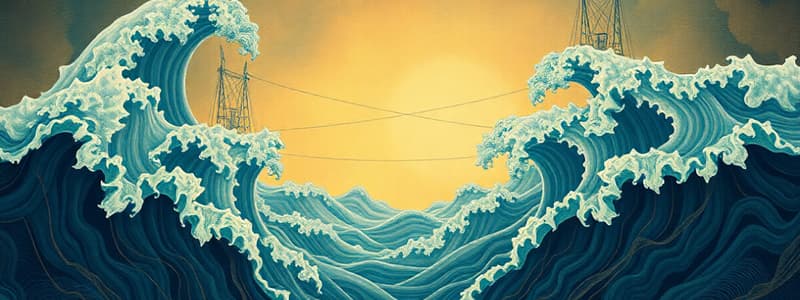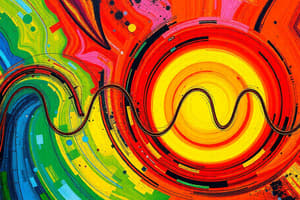Podcast
Questions and Answers
Which type of fault is most commonly associated with transform plate boundaries?
Which type of fault is most commonly associated with transform plate boundaries?
- Reverse Fault
- Thrust Fault
- Normal Fault
- Strike-Slip Fault (correct)
During an earthquake, what distinguishes the focus from the epicenter?
During an earthquake, what distinguishes the focus from the epicenter?
- The focus is the point of origin of the earthquake inside the Earth, while the epicenter is the point on the Earth's surface directly above the focus. (correct)
- The focus is a man-made point used for measurement, while the epicenter is a naturally occurring location.
- The focus only generates P-waves, while the epicenter generates both P-waves and S-waves.
- The focus is where the seismic waves cause the most damage, while the epicenter is the point of origin.
Why are S-waves crucial in determining that Earth's outer core is liquid?
Why are S-waves crucial in determining that Earth's outer core is liquid?
- S-waves are completely absorbed by the outer core, indicating that it cannot transmit shear waves. (correct)
- S-waves speed up significantly when passing through the outer core, indicating a change in density.
- S-waves change direction predictably when passing through the outer core, indicating a uniform solid composition throughout.
- S-waves convert into P-waves within the outer core, creating a shadow zone.
What information is needed from at least three seismic stations to accurately perform triangulation to locate an earthquake's epicenter?
What information is needed from at least three seismic stations to accurately perform triangulation to locate an earthquake's epicenter?
Which statement best describes the relative speeds and characteristics of P-waves, S-waves, and Surface waves?
Which statement best describes the relative speeds and characteristics of P-waves, S-waves, and Surface waves?
At a divergent plate boundary, which type of fault is most likely to occur?
At a divergent plate boundary, which type of fault is most likely to occur?
How would you determine the distance of an earthquake's epicenter from a seismograph station using the S-wave and P-wave arrival times?
How would you determine the distance of an earthquake's epicenter from a seismograph station using the S-wave and P-wave arrival times?
If a seismologist wants to understand the potential impact of an earthquake on a densely populated area, which combination of indicators would provide the most comprehensive risk assessment?
If a seismologist wants to understand the potential impact of an earthquake on a densely populated area, which combination of indicators would provide the most comprehensive risk assessment?
A region has experienced several minor tremors recently. How would a seismologist use this information in conjunction with other data to assess the overall earthquake risk?
A region has experienced several minor tremors recently. How would a seismologist use this information in conjunction with other data to assess the overall earthquake risk?
What is the order, from fastest to slowest, of seismic waves?
What is the order, from fastest to slowest, of seismic waves?
A volcano erupts with high viscosity lava and a high gas content. Which type of eruption is most likely to occur, and what hazard would be most associated with it?
A volcano erupts with high viscosity lava and a high gas content. Which type of eruption is most likely to occur, and what hazard would be most associated with it?
A volcanologist observes a newly formed volcano with steep sides, composed primarily of basaltic lava and exhibiting moderately explosive eruptions. How should this volcano be classified?
A volcanologist observes a newly formed volcano with steep sides, composed primarily of basaltic lava and exhibiting moderately explosive eruptions. How should this volcano be classified?
Consider a scenario where a remote volcanic eruption causes significant melting of snow and ice, mixing with volcanic ash and debris. Which secondary effect poses the most immediate threat to nearby low-lying areas?
Consider a scenario where a remote volcanic eruption causes significant melting of snow and ice, mixing with volcanic ash and debris. Which secondary effect poses the most immediate threat to nearby low-lying areas?
A seismologist is comparing the Richter scale and the moment magnitude scale. What key difference should the seismologist consider when deciding which scale is most appropriate for measuring a very large earthquake?
A seismologist is comparing the Richter scale and the moment magnitude scale. What key difference should the seismologist consider when deciding which scale is most appropriate for measuring a very large earthquake?
An area is composed of both shield and composite volcanoes. How would a volcanologist explain the difference in eruption style?
An area is composed of both shield and composite volcanoes. How would a volcanologist explain the difference in eruption style?
In a region prone to earthquakes, new building codes are being developed. Which aspect of earthquake risk assessment should be prioritized to inform these building codes?
In a region prone to earthquakes, new building codes are being developed. Which aspect of earthquake risk assessment should be prioritized to inform these building codes?
Flashcards
Earthquake
Earthquake
Vibrations in the Earth's ground due to the movement of plates at fault lines.
Fault
Fault
A break in Earth’s lithosphere where one block of rock moves toward, away from, or past another.
Strike-Slip Fault
Strike-Slip Fault
Occurs at transform plate boundaries where plates slide past each other horizontally.
Normal Fault
Normal Fault
Signup and view all the flashcards
Reverse Fault
Reverse Fault
Signup and view all the flashcards
Seismic Waves
Seismic Waves
Signup and view all the flashcards
Focus (Earthquake)
Focus (Earthquake)
Signup and view all the flashcards
Epicenter
Epicenter
Signup and view all the flashcards
Moment Magnitude Scale
Moment Magnitude Scale
Signup and view all the flashcards
Modified Mercalli Scale
Modified Mercalli Scale
Signup and view all the flashcards
Volcano
Volcano
Signup and view all the flashcards
Convergent Plate Boundary
Convergent Plate Boundary
Signup and view all the flashcards
Shield Volcano
Shield Volcano
Signup and view all the flashcards
Composite Volcano
Composite Volcano
Signup and view all the flashcards
Cinder Cone Volcano
Cinder Cone Volcano
Signup and view all the flashcards
Caldera
Caldera
Signup and view all the flashcards
Study Notes
- Earthquakes and volcanoes are caused by geological processes.
Earthquakes
- An earthquake is the vibration of the Earth's ground.
- This is due to the movement of plates at fault lines.
- Most earthquakes occur along plate boundaries.
- A fault is a break in Earth's lithosphere.
- It is where one block of rock moves toward, away from, or past another block of rock.
- A strike-slip fault occurs at transform plate boundaries.
- A normal fault occurs at divergent plate boundaries.
- A reverse fault occurs at convergent plate boundaries.
- Seismic waves are energy that travels as vibrations on and in Earth.
- The focus is a point inside Earth where the earthquakes first start.
- The epicenter is the location on Earth's surface directly above the focus.
- P-waves travel in a push-pull motion and are the fastest-moving seismic waves that can travel through solids and liquids.
- S-waves are slower than p-waves, but faster than surface waves and only travel through solids.
- Surface waves move in a rolling motion and are the slowest seismic wave, and cause the most damage to Earth's surface.
- Scientists determined that Earth's outer core is liquid, because the s-wave cannot travel through liquids, but p-waves can travel through both solid and liquids.
- Scientists use triangulation to find an earthquake's epicenter.
- This involves finding the time difference between P and S wave arrival, determine the distance from the epicenter using an earthquake distance graph, and locating where circles intersect on a map.
- The Richter Scale measures the amount of ground motion at a given distance.
- The Moment Magnitude Scale measures the total amount of energy released by an earthquake.
- The Modified Mercalli Scale measures the intensity of an earthquake based on the amount of damage, and is measured on a scale of I-XII.
- Seismologists use 5 indicators to assess earthquake risk, including past earthquakes, probability, population density, geology around a fault, and building design.
Volcanoes
- A volcano is a vent in Earth's crust through which molten rock flows.
- Volcanoes form at convergent plate boundaries.
- Volcanoes form at divergent boundaries, such as mid-ocean ridges and rift valleys.
- Volcanoes form at hot spots, like Hawaii, that are not associated with plate boundaries.
- The three types of volcanoes are shield volcano, composite volcano, and cinder cone volcano.
- Shield volcanoes are large, shield-shaped volcanoes with gentle slopes and eruptions.
- Composite volcanoes are large, steep-sided volcanoes that result from explosive eruptions.
- Cinder cone volcanoes are small, steep-sided volcanoes that erupt gas-rich, basaltic lavas and have moderately explosive eruptions.
- A caldera is a large volcanic depression created when the summit of the volcano collapses during a violent eruption.
- There are two types of eruptions.
- Violent eruptions occur when lava has high viscosity and gas content.
- Quiet eruptions occur when lava has low viscosity and gas content.
- The effects of volcanic eruptions include lava flows, ash fall, mudflows, and pyroclastic flows.
- Lava flows move slowly, can destroy towns, and are rarely deadly.
- Ash fall can cause breathing problems, cool Earth's atmosphere, and disrupt air traffic.
- Mudflows can cause snow and ice to melt and mix with mud/ash.
- Pyroclastic flows can be deadly and throw gas, ash, and rock into the air.
- Scientists predict volcanoes by observing ground deformation, monitoring increases in earthquakes and volcanic gases, and tracking the acidity of water near the volcano.
- Volcanic eruptions affect climate, because volcanic ash can block the sun and cause a decrease in global temperatures, and cause acid rain.
Studying That Suits You
Use AI to generate personalized quizzes and flashcards to suit your learning preferences.




